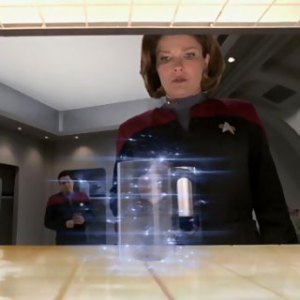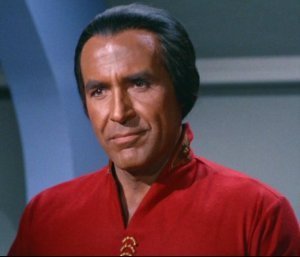Steven Lyle Jordan's Blog, page 33
February 13, 2015
Verdant Skies is now in print!
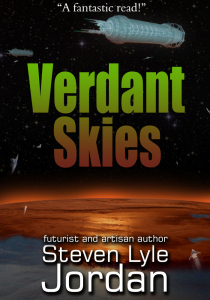 The trigger has been pulled: Verdant Skies is now a printed book, available now at Createspace and (in a few days) at Amazon.com.
The trigger has been pulled: Verdant Skies is now a printed book, available now at Createspace and (in a few days) at Amazon.com.
This is my first book to see print (if you don’t count the occasional PDF that someone has printed here or there)… and it was worth enough work to make everything as perfect as possible, that the text didn’t just get re-proofed, it earned a third revision.�� So, it’s not only a “first time in paperback” edition, but it’s new and improved, to-boot!
If you’re one of those people who want your fiction printed���or you know someone else who does���now’s the time to check out this great novel.�� If it looks good, let me know… that, and sales, will dictate whether I’ll continue this trend with Verdant Pioneers, the sequel to Verdant Skies, and with any of my other books.

February 7, 2015
What would get us to Star Trek’s utopia?
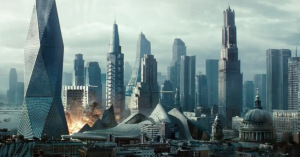 Nilofer Merchant, in a TED guest post from 2014, described his belief that the technological world of Star Trek has largely overtaken us (obviously, we’re not visiting other planets yet)… and the best news of all, that we should expect to reach the social world of Trek within 30 years.�� And how could we not want to achieve Gene Roddenberry’s dream of a utopian Earth and bright, bright future?
Nilofer Merchant, in a TED guest post from 2014, described his belief that the technological world of Star Trek has largely overtaken us (obviously, we’re not visiting other planets yet)… and the best news of all, that we should expect to reach the social world of Trek within 30 years.�� And how could we not want to achieve Gene Roddenberry’s dream of a utopian Earth and bright, bright future?
Yet, there’s one thing that Nilofer neglects to mention, and it only happens to be the one absolutely non-negotiable thing that we on Earth must accomplish, or we won’t see Roddenberry’s utopia in 30 years, 300 years or 3,000 years.
In short, we need universal guaranteed minimal living conditions.
Key to Star Trek‘s vision of the future was that everyone on Earth���and supposedly, throughout the entire United Federation of Planets���was that everyone, absolutely everyone, lived comfortably, did not get cold or go hungry, and did not even need money on a daily basis to survive.�� Yes, there were people in the Federation who chose to do more than simply exist: Some of them became merchants, created art, or explored the stars.�� But though it was never shown on the TV series, it was presented in many of the books written in the Star Trek universe: If you didn’t want to do anything, you didn’t have to do anything… and you still had a good roof over your head and three squares a day to keep you sated.
Today’s economists are now spreading the word that about one tenth of a percent of the world’s population holds about ninety-nine percent of its wealth.�� More than a few suggest that, if that wealth was evenly distributed among the world’s population, we could enjoy a universal living state, living wage and social services enough to sustain everyone on Earth (not to the standards enjoyed by much of the developed West, I’m afraid, but yes, sustainable).
 And so people are asking: What would it take to evenly distribute that wealth?
And so people are asking: What would it take to evenly distribute that wealth?
That is the social, political and financial revolution that would be required to achieve Roddenberry’s utopian Earth.�� And it will probably take nothing short of a global calamity to kick something like that into motion.�� Because, of course, the one-tenth percent like their lives and fortunes, and have no plans to give them up.�� In order to be willing to give them up, they would surely want a guarantee that they’d continue to live well, like they do now… which, by definition, wouldn’t happen.
And even beyond that one-tenth percent: Imagine you, a relatively comfortable urban or suburban Westerner, were told that you could have a guaranteed minimal living condition and wage… and it would be roughly analogous to living in a smallish motel room and your fair share of veggies and mushrooms to fill your tummy?�� Most Westerners wouldn’t be too keen on that idea, either.�� Everyone wants steaks in their penthouse.�� How could you get them to settle for less?
So, short of a calamity, like an asteroid strike or World War III, that would force absolutely everyone (and probably smaller numbers of them) to start over from scratch, it’s pretty hard to picture the future Earth’s utopia.�� Most of the new governments and social systems humans have developed over the years were as a result of financial, organizational or political upheaval that demanded new systems to be conceived to move forward.
On the other hand… Roddenberry’s Star Trek did predict that the world would suffer two additional major wars (World War III and a Eugenics War) and resultant societal collapse, and the utopian future would result from the efforts of recovering from those events.�� And Roddenberry’s ideas reflected the concepts H.G. Wells envisioned in Things to Come (a movie that came out when Roddenberry was a teen, and which certainly inspired him).
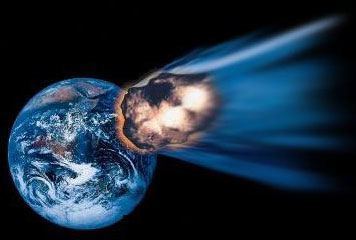
Change is a-comin’…
So, great… we need a global disaster. And the thing about disasters is, they’re usually pretty hard on the populace.�� That means we may just get our utopia… but a hell of a lot of us won’t live long enough to see it.�� Could we get there any other way… say, by a global consensus of political leaders, working together to redistribute resources and create the new utopia?
I hate to say it… but I’d put my money on the disaster.
Well, okay, okay: There is one other thing that could do it.�� A single, incredible technological development could elevate everyone on Earth to a comfortable���even modern Western���living standard, and remove the need to work for a living.�� Maybe this is what Nilofer believes we will manage to invent within the next 30 years.
Those cool devices that can, through some inexplicable manner, turn raw energy, miscellaneous atoms and stored matter patterns into food, clothing, tools, art… probably sex robots… anything you desire.�� If we could develop replicators, we could start churning out anything for anyone, and quickly have us all living the life of Reilly.�� And now that we’ve started on 3-D printers, and are learning how to combine more complex elements in the printing process, we’re on the road to replicator technology by 2045!�� Right?
Well, we’ll see.�� And I guess we’ll see which gets here first: The replicator-produced future utopia; or the asteroid strike.

February 5, 2015
Are eugenics at our doorstep?
Mitochondrial donation.�� These two words are poised to create a firestorm of controversy around the world, as some governments are considering allowing parents who use in-vitro techniques to have children, to allow mitochondrial DNA from a third donor to replace some of the existing mitochondrial DNA in the egg.�� Based on a procedure called cytoplasmic transfer pioneered in the 1990s, the method is intended to prevent the passing on of inherited and incurable diseases through mitochondrial DNA, which is carried from mother to child.
But naturally, when most people hear anything about this, they picture Khan:
 And they predictably freak out.�� Are we at the doorstep of the long-feared eugenics program?
And they predictably freak out.�� Are we at the doorstep of the long-feared eugenics program?
Here’s a better question: If we are at the forefront of a eugenics program… should we really expect to get “genetic supermen” taking over the world and culling the rest of us?�� I’d say, no more than we worry about, say… fanatic religious terrorists taking over the world and culling the rest of us.�� The fact is, it takes more than a dedicated group of people, whatever abilities they have, to take over the world today.�� The world is not only too interconnected, but too fearful of its neighbors, to allow that to happen.�� I think we can dismiss the blatantly simplistic suggestion that genetically superior beings will somehow take over our world.
So, looking at this more practically: What we are talking about is eradicating the threat of some diseases in newborn children, something we have been working on in other ways for the last few decades.�� Scientists have been experimenting with the manipulation of DNA to prevent genetically-inheritable diseases (like sickle-cell anemia) for years.�� Mitochondrial donation is yet another way to accomplish this, and it shows great promise.
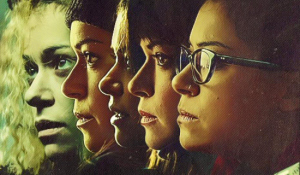 But the mitochondria do not control things like hair color, eyes, build, weight or skin color.�� In other words, you cannot use this method to “tailor” the look or abilities of your child.�� Nor is this “cloning,” the use of a single parent’s DNA to birth a genetically-matching child or children.�� If done properly, a parent will end up with a child less likely to develop the diseases their parents were susceptible to.�� And that’s it.�� After that, “nurture” takes over, and the child will become what their parents and environment make of them.
But the mitochondria do not control things like hair color, eyes, build, weight or skin color.�� In other words, you cannot use this method to “tailor” the look or abilities of your child.�� Nor is this “cloning,” the use of a single parent’s DNA to birth a genetically-matching child or children.�� If done properly, a parent will end up with a child less likely to develop the diseases their parents were susceptible to.�� And that’s it.�� After that, “nurture” takes over, and the child will become what their parents and environment make of them.
What about the “genetic superman” threat… is it that far-fetched?�� Maybe not completely; but it’s not likely to come from this direction of DNA experimentation, which is too slow and too likely to be impacted by other factors to be effective.�� Then should we expect that from some other vector?
Well, you might want to give a hard look at your local pharmacist’s counter… as well as your nearest GNC.�� Oh, and the internet.�� The fact is, more and more drugs and compounds are being developed, designed to build stronger bones and muscles, develop better brainpower, speed up reflexes, etc, every day.�� The catch, so far, is… they pretty much don’t work.�� The human body has proven it is more capable of developing better physical and mental condition through recognized and presently available diet, exercise and mental activities than anything that comes out of a pill, shot or powdered drink.�� (With the exception of steroids… but steroids are basically synthetic variants of the hormones already in the human body, not completely new chemical compounds.)
But we develop new drugs every day, refine others, and occasionally find that a drug developed for one thing is very good at doing or preventing something unexpected and beneficial.�� At some point, some of those new drugs just might turn out to be very safe and effective at what they are intended for.�� And if there turns out to be a demand for it, it will be almost impossible in today’s world to prevent people from getting access to it.
If we’re lucky, the first of such drugs will do things like quickly cleaning and repairing arteries, repairing heart or lung damage, containing cancers and restoring brain functions lost to age or degeneration or injury.�� If we get those, we will all end up healthier, smarter and longer-lived.
But will that make us susceptible to some zealot’s entreats to beat down our inferiors and take over the world?�� The good and bad news is: Humans hardly need genetic superiority to listen to zealots.�� If you’re worried about some group trying to rule the world, my advice would be not to wait until modern medicine makes us better and stronger to look for them.

February 1, 2015
New Free Read: Monster
 I’ve added a new short to the Free Reads page: Monster, a writing challenge from the SciFi Ideas website.
I’ve added a new short to the Free Reads page: Monster, a writing challenge from the SciFi Ideas website.

January 29, 2015
Science is the bad guy now?
 It’s been suggested in a Tor.com article that moviemakers only see science and technology as the bad guy, and won’t greenlight a movie that presents science and technology in a positive light.�� And if you think about the sci-fi movies of recent years, it’s pretty damned hard to think of any where the science or tech didn’t create or exacerbate a problem.
It’s been suggested in a Tor.com article that moviemakers only see science and technology as the bad guy, and won’t greenlight a movie that presents science and technology in a positive light.�� And if you think about the sci-fi movies of recent years, it’s pretty damned hard to think of any where the science or tech didn’t create or exacerbate a problem.
Same thing for television: How long has it been since we’ve had a new TV show about someone using technology to help people?�� You could mention Person of Interest; but even that show, wherein a genius siphons the identifying numbers of people who need help from an all-seeing Machine, has become thoroughly overshadowed by the discovery of another Machine that apparently wants to help a secret organization to (ahem) Take Over The World, and an imminent Machine-on-Machine war.�� Extant was about taking advantage of humans alone on a space station to expose them to aliens.�� Ascension was about fooling a bunch of “colonists” into thinking they’re on a space ship to another star.
I often find myself outright gobsmacked by the idea that people would consider science and technology as the bad guy in any form, considering all we have to thank science and technology for.�� I mean, if we didn’t have agriculture… animal husbandry… medicine… metallurgy… standardized weights, measures and time… engineering… electronics… communications… all of which are branches of science… we’d still be living like nomads on the plains, throwing rocks at rabbits and trying to guess which leaves were safe to eat.�� Or we wouldn’t exist at all, finally wiped out by the apex predators on every continent.
So, if science and technology have made our very lives and societies possible today… how are they the bad guy now?
It’s a popular statement that people tend to fear what they don’t understand, and that they don’t understand science today.�� But in fact, there’s little about science and technology that’s that incomprehensible to the average person.�� In fact, if you can understand the rules of American football and remember the names and numbers of your favorite players, you have the mental capacity to understand 90% of the science and technology you’re likely to come across in daily life (and another 5% of the science and tech you don’t usually get exposed to).
Most Americans have apparently decided that they don’t want to apply themselves to learning about science and technology… except, of course, when it’s convenient.�� Like figuring out how to drive a car.�� Or use a cellphone.�� (Further proof of Jordan’s Theorem: “You get used to what you want to get used to.”)
And people aren’t scared of cars or cellphones, even though they have a very good reason to be afraid of cars, one of the deadliest inventions ever devised by Man… or cellphones, one of the most socially disruptive technologies since… I dunno, the car, probably.
Disruption seems to be key here: People have decided they don’t like their lives to be disrupted by change, and few things change people’s lives faster than technology does.�� What I don’t get is why people dislike change so much; after all, it’s not as if our lives are perfect the way they are.�� (Excuse me if your life actually is perfect… obviously, I’m not talking to you.)�� Wouldn’t smarter cars, safer airplanes, better communications options, more helpful appliances and faster computers be things we’d look forward to having?
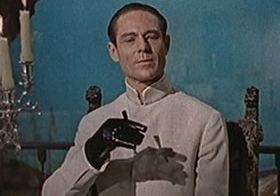 And how many of the bad things we attribute to science and technology are actually caused by science and technology?�� When we worry about more pervasive surveillance… machines run amok… damage to our world… aren’t we, in fact, worrying about ways in which people have misused machines?�� The atom bomb may be capable of killing millions… but people decided to drop two of them on Japanese cities, not some evil AI.�� People shoot guns.�� People cause car accidents.�� People design malware.�� People hack into credit databases.�� People do experiments carelessly and cause problems.�� People disable park computers and allow dinosaurs to run amok.�� People program hostility into attack machines and become hunted into extermination.�� People ransom governments using energy sources that could power the world.
And how many of the bad things we attribute to science and technology are actually caused by science and technology?�� When we worry about more pervasive surveillance… machines run amok… damage to our world… aren’t we, in fact, worrying about ways in which people have misused machines?�� The atom bomb may be capable of killing millions… but people decided to drop two of them on Japanese cities, not some evil AI.�� People shoot guns.�� People cause car accidents.�� People design malware.�� People hack into credit databases.�� People do experiments carelessly and cause problems.�� People disable park computers and allow dinosaurs to run amok.�� People program hostility into attack machines and become hunted into extermination.�� People ransom governments using energy sources that could power the world.
In Person of Interest, it is people in the government and people running defense contracts who use the show’s AIs to do bad things.�� In Extant, a NASA executive directs the program that exposes astronauts to the aliens he knows are at the orbiting satellite.�� In Ascension, people set up the experiment that cons colonists into thinking they are on a space ship.�� People take a new science or technology, an essentially neutral thing… and by their actions, make it bad.
So, when we say we don’t like technology���that we’re afraid of science and technology���we’re really saying we don’t like and are afraid of the people who corrupt the science and technology.�� We’re blaming the bathwater for being dirty… not the dirty baby put into the bathwater.
You might argue that this is just semantics… but it’s very important, when you have a problem, to recognize the true cause of that problem.�� Otherwise, you’ll never be able to fix it.�� And to fix this problem, we all need to understand:
Science and technology don’t hurt people.�� People do.

January 27, 2015
Rationalizing Createspace and printed books
 “I don’t do e-books.�� But if your book was in print, maybe I’d check it out.”
“I don’t do e-books.�� But if your book was in print, maybe I’d check it out.”
Yeah, if I had a dollar for every time I’ve heard that, I could afford that Tesla I’ve been eyeing.�� (Who am I kidding?�� I could afford that Galactica full series DVD set I’ve been eyeing.)�� Seriously, it’s a lament that I’ve heard many times, from friends, family and potential customers.�� But when it came up on Facebook recently, I was recommended to check out Createspace to solve the printed book dilemma.�� I’ve decided to try it���but before I did, I had to do something important: Find a way to rationalize it.
Createspace (owned by Amazon.com) is a partial solution to the high cost of printing copies of your cool novel.�� Instead of expensive mass printing, leaving someone (possibly the author) with a hole in their wallet and boxes of books with no place to go, Createspace will print them on-demand, one at a time, and ship them directly to the customer.�� Individual books will cost more than mass-produced paperbacks… but they will be on paper, something so many people still demand.
 Now, although this may sound like an ideal solution to many, it isn’t one to me.�� Why?�� Because I still believe, in every fiber of my being, that we need trees more than we need paper.�� The environment takes a significant hit from every piece of paper manufactured, and not just from trees cut down:
Now, although this may sound like an ideal solution to many, it isn’t one to me.�� Why?�� Because I still believe, in every fiber of my being, that we need trees more than we need paper.�� The environment takes a significant hit from every piece of paper manufactured, and not just from trees cut down:
Felled trees take habitats away from local animals and can no longer prevent erosion or fix carbon from the atmosphere;
Said trees need to be transported to mills, generally by diesel-belching trucks and tractors;
Incredible amounts of drinkable water and valuable electricity are required to pulp wood;
Bleaches and other chemicals are used to give paper its color and texture, said chemicals generally being dumped with the used and dirty water into the local ecosystem after being used;
The machines that do the milling work need to be serviced, which requires oils and other chemicals that also end up dumped into the local ecosystem;
Newly-created paper must be driven to printers, requiring more diesel-soot-belching trucks;
Printers print onto the paper, often with oil-based inks, using machines that need oils, solvents and other materials for servicing;
Printed materials must be delivered to customers���trucks, again (though, at this stage, many of them are driving on standard gasoline, dumping carbon monoxide into the air instead of diesel soot);
After customers read the product, they may dispose of it, often immediately, resulting diesel trucks transporting them to the dump, more content in landfills, or releasing of some of the toxic chemicals used in printing the product if it is burned.
 This is why I have supported e-books since I discovered their existence, way back in the 1990s.�� Though e-book readers (either dedicated or not, as you can read e-books on cellphones, tablets, computers and laptops too) must be manufactured, indeed taking them through many of the steps illustrated for paper manufacturing above… they have the distinct advantage of being able to hold hundreds, thousands, even more, of books, magazines, comics, newspapers, brochures, pamphlets… pretty much anything that you could print.�� The economy of scale is obvious, and more than compelling enough to merit a preference for e-books if you value the ecology of this planet.
This is why I have supported e-books since I discovered their existence, way back in the 1990s.�� Though e-book readers (either dedicated or not, as you can read e-books on cellphones, tablets, computers and laptops too) must be manufactured, indeed taking them through many of the steps illustrated for paper manufacturing above… they have the distinct advantage of being able to hold hundreds, thousands, even more, of books, magazines, comics, newspapers, brochures, pamphlets… pretty much anything that you could print.�� The economy of scale is obvious, and more than compelling enough to merit a preference for e-books if you value the ecology of this planet.
Now, understand that I came from the same book world that everyone else came from, and I was more avid than many, though not as avid as some.�� I had shelves and shelves of paperbacks���hardbacks took up too much space���and boxes and boxes of books that didn’t fit on my shelves.�� But as a fan of science and science fiction, I also had an appreciation of the benefits science and technology granted us, and I saw the emergence of digital book formats and e-book readers holding thousands of books as that advantage, in spades.�� I took to them like any other sci-fi fan would take to Captain Kirk beaming into their living room and offering them a ride on the starship Enterprise.�� (Don’t wait up, Mom.)�� E-books were the book format of the future, and I was ready to take full advantage of it today.
Until now, I have been fully comfortable with offering my novels as e-books exclusively, and avoiding their mass-production in paper form.�� Yet, I’ve always been cognizant of those who outright refused to read my books, specifically because they were not on paper.�� And these numbers include members of my family and (most of) my closest friends, including those who count science fiction as a favorite genre.�� (Yeah.�� Science fiction readers.�� Foregoing the latest and greatest technology for reading.�� Honestly, I still don’t get that.)
(And speaking of parantheticals, I admit I’ve often suspected some of them use the lack of printed versions as an excuse to avoid reading my books… being that they have their doubts about the quality of any book I could write, because they know me.�� One of my friends said as much to me at a party.�� Ah, alcohol, you bitch.)
However, I find that I cannot ignore some other facts; one, that my novels aren’t selling well, mainly due to lack of effective promotion; two, that various independent authors have told me that printed books can be very effective promotional tools; three, those same authors assure me that customers are willing to buy them even at the higher prices that Createspace must charge; and four, that Createspace makes the books available, but doesn’t actually print anything until customers order them, thereby minimizing the above-illustrated waste stream of printed matter as much as possible.
And so, given the evidence and anecdotes at hand, I’ve decided to give Createspace a try, starting with one of my best novels, Verdant Skies.�� Once I’ve okayed Createspace’s proof copy, I’ll make it available to the public, consider sending copies to promoters who shy away from e-book content, and any other venues in which I can use the books to promote myself.
For me, this is purely a promotional experiment.�� I’ll get no particular pleasure or pride out of seeing my work in paperback form, being that it’s a medium that no longer impresses me.�� But if printed books sell, lead people to my other books, and generate a significant income from book and/or e-book sales, then I can’t in good conscience ignore them.�� I’d still rather people bought my novels as e-books… but I’ll swallow my personal preferences and make my entire catalog available, if there’s a clear demand for them.
And that, after all is said and done, is the issue: Whether I can promote the books well enough to generate demand.�� Having printed books is not a sure road to success; we still have to see what I can do with them.

January 23, 2015
Robots as female fetishes and voodoo dolls
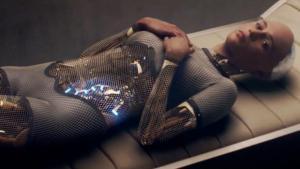 In a Den of Geek article, filmmaker Alex Garland discussed his latest film, Ex Machina.�� He had some interesting things to say about the story and the robotic main character, Eva, that caught my attention:
In a Den of Geek article, filmmaker Alex Garland discussed his latest film, Ex Machina.�� He had some interesting things to say about the story and the robotic main character, Eva, that caught my attention:
It���s partly an argument about the objectification of women in a particular way. In this sense, it���s a literal objectification.
Eva���s not actually a woman. She���s a machine that does not have a gender. So the question is, why is she presented as a girl in her early 20s? It���s because we fetishise girls in their early 20s. In a particular kind of way. Sometimes you read about that being shunted onto the media: advertising does it, film does it. It���s bullshit. It���s passing the buck. We all do it. Men do it and women do it. Right?
The reasons we do that are complicated, and I could make guesses as to why it is. But what seems to be beyond debate is that it does actually happen.
Women (in many countries, like the US) intentionally dress, use makeup and style their hair to fetishize themselves, even in socially- and politically-non-sexual situations (like office environments)���even as they demand to be seen as something more than fetish objects���and men, claiming to indeed see women as more than fetish objects, don’t actively discourage women from fetishizing themselves.�� And science fiction goes the extra mile:�� Objectifying women by robotizing them, as shown in Ex Machina, is as old as the first movies, and has become a rather tired trope of the genre that we cannot get away from, even today.
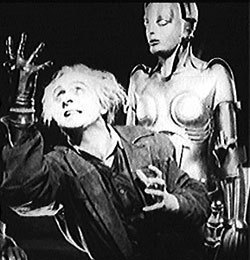
Rotwang and the robot: With a central character removed from the butchered script, the brilliant but tortured inventor becomes the prototypical Mad Scientist, and the robot’s female appearance becomes confusing and pointless.
It’s interesting to me how often this fetishization of the female form is played out in sci-fi with robots.�� Female robots are usually presented as femme fatales, gorgeous and often innocent creatures clearly designed superficially to respond to men’s libidos, whatever their intended function.�� In a way, they represent the woman it is permitted to want… and because it is not actually human, permissible to take without fear of reprisal���they are female slaves, as Garland points out, literal fetishizations of the female body.
And this happens much more to female-designed robots than male-designed robots.�� Aficionados can go all the way back to Fritz Lang’s Metropolis to see the inventor, Rotwang, capable of creating the first mechanical person, designing a robot in the image of the woman he loved and lost to another man (in the original novel, Rotwang was commissioned to create machine-workers, but chose to create a simulacrum of his lost love first); the robot is eventually given the form of a girl the story’s hero pursues, using sexual allure to provoke a riot… becoming a driving plot-device, not a character.�� Metropolis presents woman as sexual fetish, as pure story vehicle, a thing for other characters to chase, to win (or lose).
Westworld features robot women specifically designed to be willing sex partners.�� In Blade Runner, out of the four replicants that illegally reach Earth, two male and two female, three of them are combat robots���the fourth, the pleasure model, is a female.�� And the other female hides in plain sight working as an exotic dancer…�� (okay, let’s just cut to the chase: If you want to see how many female robots there have been in TV and movies, there’s a webpage for that.�� Trust me, there’s lots.)
A recent movie, The Machine, gives us a male scientist working on creating a robot out of the many prosthetic parts being developed for wounded soldiers; and when his beautiful assistant is killed, he uses her as a template to create the robot’s final form.�� Though the robot turns out to be a badass fighter, the audience is first shown her in varying states of dress (including fully naked), and characters react predictably when they see the sexy robot and the scientist together… the characters, and the audience, see her quite clearly as a fetish.�� And it is part of the dichotomy of the character (and a typically sci-fi kick to a man’s psychological nuts) that such an innocent-looking and sexually-alluring creature is also a cold-hearted killer.
 There’s a lot of slightly twisted psychology going on here, touching on sex, domination, power trips and revenge fantasies by (and against) women, using robots as the voodoo dolls we can manipulate as we see fit, in order to convince ourselves that we are not sub-consciously visiting these manipulations upon real women somewhere else. This often says more about us as a people than most of us would care to admit.
There’s a lot of slightly twisted psychology going on here, touching on sex, domination, power trips and revenge fantasies by (and against) women, using robots as the voodoo dolls we can manipulate as we see fit, in order to convince ourselves that we are not sub-consciously visiting these manipulations upon real women somewhere else. This often says more about us as a people than most of us would care to admit.
In Sarcology, I presented a male robot, originally designed for the very psychologically-male-centric aggressive roles of police and combat duties, but who becomes a surrogate for a male character and provides comfort to a woman.�� In writing Sarcology, I was seeking a turnaround from the usual robot-human gender roles, where male-gender robots are generally used as aggression fetishes themselves, to threaten women (or to stand between women and a threat).�� The robot in Sarcology graduates from being a fetish object at the beginning of the story to becoming a fully-realized character in its own right.
Will we ever reach a point when our robots are not commonly designed to emulate a gender, male or female, accompanied by whatever sexual baggage that entails?�� Or would a decidedly gender-neutral robot push even more of our “uncanny valley” psychological buttons?

January 22, 2015
The Iron Giant can be pre-ordered
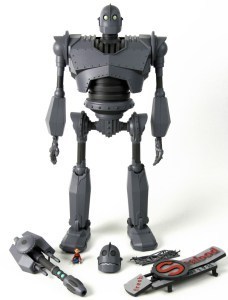 Mondo is now allowing customers to pre-order the Iron Giant 30= articulated figure, complete with accessories!�� You can also pre-order the replica Iron Giant Bolt (the one that wanders across the snow to find the Giant), and the disembodied Giant Hand that wanders into Hogarth’s house.
Mondo is now allowing customers to pre-order the Iron Giant 30= articulated figure, complete with accessories!�� You can also pre-order the replica Iron Giant Bolt (the one that wanders across the snow to find the Giant), and the disembodied Giant Hand that wanders into Hogarth’s house.
At $300, maybe something for die-hard collectors only… or over-50 guys with a love for this movie and a bit of disposable income…

January 19, 2015
Top 20 list defines sci-fi for 2015

Meet the iconic image of 21st century sci-fi.
My post about the Rolling Stone top-20 sci-fi movies of the 21st century���and my version of the top-20 list���inspired some interesting comments from all over, making clear that (ahem) my opinion about what makes the best sci-fi movies is shared by some, but not necessarily all, of the sci-fi lovers out there.�� Of course, as I pointed out in many places, my opinion is my opinion, your opinion is your opinion, and that’s as far as opinions go, pretty much.
But the discussion was useful in another way: That is, to help define what constitutes sci-fi for the audience of 2015.�� This is largely an academic exercise, but for those who seek to create sci-fi to be consumed by the populace (and make them a lot of money), if might be worth taking a quick look over these conclusions to make sure you’re doing it right.
So, in order to attract the typical audience of 2015 to your sci-fi, remember these guidelines:
1. Science is just a word.�� Sci-fi is about science.�� But science is just a word.�� And a really vague word, at that.�� Anything can be said to have a science behind it, i.e.: The science of healthcare.�� The science of hair care.�� The science of Hobbit diets.�� The science of leaves.�� The science of rainbows.�� The science of magic.�� See what I’m getting at?�� There’s a science for everything.�� Therefore, everything can be in a sci-fi product.
2. Sci-fi must have something associated with science in it.�� So, put a blaster in your heroes’ hand, or put your dragon-slaying action on a space ship, and it’s sci-fi.�� Or just use any of the following words or phrases: A.I.; robot; laser; nuclear; atomic; FTL; nano; zero-point energy; cyber; force-field; warp; telepathic; hoverboard.
3. Physics… shmysics.�� Physics is not 100% known.�� Scientists haven’t solved every mystery out there.�� And that means that, outside of the things that have been discovered… anything is possible.�� Literally anything.�� You want planet-sized robots?�� Go ahead.�� Since we haven’t discovered all the physics about materials, we don’t know that a continent-sized piece of aluminum is impossible to make.�� Wanna go faster than light?�� Wanna travel back in time and sleep with your grandmom?�� Since physics doesn’t know everything… there’s really nothing stopping you.
4. Don’t lecture.�� A recent Facebook poster said: “If I want to learn science, I’ll read a science journal.”�� So, unless you write science journals, take note that your sci-fi audience doesn’t want to learn stuff.�� Leave knowledge out.�� Sci-fi is only good for entertainment.
5. Don’t sneak no book stuff on me.���� Sci-fi fans, by and large, don’t read.�� As children, they were read to by parents… in order to put them to sleep.�� Then they discovered TV.�� Game over.�� They don’t want movie versions of famous books by famous authors… because they probably never heard of ‘em.�� If it’s a real famous book, feel free to use its name in your movie’s title.�� But don’t worry about putting any of the book’s content in there… they couldn’t care less how one compares to the other.�� (Okay: Some sci-fi fans read.�� Mostly books based on the video games they play and movies they watch, except with more of the sex and violence the law won’t let them put into the games and movies.�� 50 Shades of Mass Effect, anyone?)
6. “The human condition”?�� It better be “hot.”�� Sci-fi fans don’t want any of that “human condition” noise, that’s that psychological crap dad talks about from that ancient Star Trek show.�� What’s important is cuteness, hotness, funny-ness, badassiness and boringness (hey, gotta know who to avoid).
7.��The more things that make a story exciting, the better.�� Today’s sci-fi fans grew up on FPSs.�� The Star Wars franchise started before they were born.�� Movies are defined by the size of their spaceships, the toughness of their action stars and the coolness of their explosions.�� And dragons.�� And light-sabers.�� And aliens we can have sex with.�� (Or blow up.)�� And the un-dead.�� And time-travel.�� And magic flying spells.�� And guns four times our size that can vaporize tanks with no recoil.�� No, they have nothing to do with science.�� They have everything to do with awesome.
8. Can it be made into a video game?�� Then it’s a good story.�� (Corollary: If it was a great video game, it could make a great movie; just make sure you leave in all the sick stuff that made it such a great game.)
9. Logic?�� That’s so 20th century.�� Today’s sci-fi doesn’t care about logic.�� It cares about epic.�� Spock doesn’t reason with people anymore���he beats on them and cries on Uhura’s shoulder.�� Robots attack people because they’re as bat-shit crazy as you are.�� Logic is for geeks.�� Don’t be a geek.
10. Problem solving = Blow it up.�� No more problem.�� Pretty self-explanatory.
This list of definitions makes it clear why movies like Cloverfield, The Host, Monsters, Reign of Fire, Gravity and Attack the Block make the Rolling Stone list of top-20 movies, while movies like Interstellar, Snowpiercer and Vanilla Sky do not: The former movies are products of 21st century sci-fi; the latter are examples of 20th century sci-fi.
Armed with this list, any author should now be able to create their sci-fi opus, and see incredible fame and rafters-shaking success in no time. They will also understand why I can’t sell any books to the modern sci-fi audience.
Oh, one last thing: Don’t like the word “sci-fi”?�� Just call it “fantasy”.�� It’s pretty much the same thing.

January 16, 2015
Best 21st century sci-fi movies? Not quite, Rolling Stone.
 Rolling Stone magazine did an okay job with their top 20 sci-fi movies of the 21st century list. (Let’s just keep calm, ignore the fact that the 21st century has only had 15 years in it so far, and carry on.)
Rolling Stone magazine did an okay job with their top 20 sci-fi movies of the 21st century list. (Let’s just keep calm, ignore the fact that the 21st century has only had 15 years in it so far, and carry on.)
There’s one obvious thing about the movies that I have to nitpick right off, and it comes in one word:
Monsters.
See, to me, monsters aren’t sci-fi; they are fantasy.�� Because they are hands-down impossible and/or stupid.�� And, therefore, have no business in a sci-fi list.�� Move them to some list that includes ghosts, wizards and hobbits.�� That means that certain movies should be removed from this list.�� The biggest offenders are:
The Host
Cloverfield
Monsters (duh)
Reign of Fire (a close one, admittedly; but since it’s based on the idea that dragons have always existed, and just recently awoke from hibernation���and no archeologist has yet to find a sleeping dragon or the species’ fossils���I am forced to add this to the fantasy monster list.)
Which leaves us a list of 16 movies.�� Which is good, because I know just which movies were omitted from the Rolling Stone list that I would add to create a well-rounded 20 monster-free sci-fi movies.��
Not in any particular order:
Solaris (2002)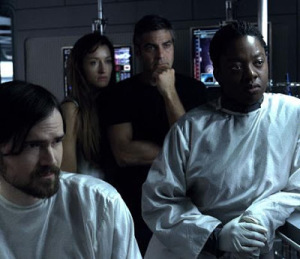 Although author Stanislaw Lem didn’t particularly approve of either attempt to cinematize his SF novel, my feeling is that Steven Soderbergh did a fantastic job in capturing the claustrophobia and creepiness of a remote space station, and its small scientist crew trying to figure out how and why people from their past have appeared on the station, their mere presence tormenting them over memories from their past.�� One of the rare SF stories that delves into the human psychological condition, as well as presenting viewers with the relatively unheard-of concept of an alien intelligence so different that we will likely never understand it or learn to communicate with it, any more than a bacteria could make contact with us from the surface of our scalps.�� (Personally I agree with Lem in that I wish they’d spent more time on the unfathomable nature of Solaris itself, not just the goings-on on the station.�� But oh, well.)
Although author Stanislaw Lem didn’t particularly approve of either attempt to cinematize his SF novel, my feeling is that Steven Soderbergh did a fantastic job in capturing the claustrophobia and creepiness of a remote space station, and its small scientist crew trying to figure out how and why people from their past have appeared on the station, their mere presence tormenting them over memories from their past.�� One of the rare SF stories that delves into the human psychological condition, as well as presenting viewers with the relatively unheard-of concept of an alien intelligence so different that we will likely never understand it or learn to communicate with it, any more than a bacteria could make contact with us from the surface of our scalps.�� (Personally I agree with Lem in that I wish they’d spent more time on the unfathomable nature of Solaris itself, not just the goings-on on the station.�� But oh, well.)
A.I. (Artificial Intelligence)�� (2001)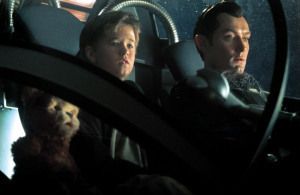 This movie, produced by Steven Spielberg from a Stanley Kubrick workup of a Brian Aldiss short story, tends to get short shrift by the anti-cuteness brigades, but it actually does a great job showing us a world in which robots have become integrated into society, only to become second-class citizens that clearly want more in their lives.�� Although the ending seemed too pat for audiences, the journey of the robot David and his companions, Gigolo Joe and Teddy, to find the Blue Fairy that David believes will make him a real boy, is compelling and sympathetic… in some cases, the robots seem more alive than the humans around them.
This movie, produced by Steven Spielberg from a Stanley Kubrick workup of a Brian Aldiss short story, tends to get short shrift by the anti-cuteness brigades, but it actually does a great job showing us a world in which robots have become integrated into society, only to become second-class citizens that clearly want more in their lives.�� Although the ending seemed too pat for audiences, the journey of the robot David and his companions, Gigolo Joe and Teddy, to find the Blue Fairy that David believes will make him a real boy, is compelling and sympathetic… in some cases, the robots seem more alive than the humans around them.
War of the Worlds (2005)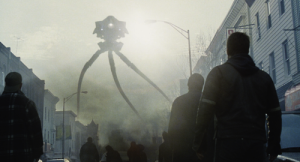 This isn’t even close to a remake of the George Pal film of the 1950s; rather it is much more closely based on the original H.G. Wells novel, brought forth into present day.�� Though the presence of director Spielberg and actor Tom Cruise tend to overshadow the work and make people more critical of it, in fact this movie much better captured the personal horror of being caught in the middle of an alien invasion, and simply trying to escape certain death in a helpless, totally overwhelming situation… exactly what Wells was trying to capture in the novel, itself a retelling of the British invasions of primitive islands during its colonization period.�� Cruise’s Everyman is very satisfying (one of those films that reminds us that this action star is a great actor, too), the atmosphere and effects are impeccable, and the scale is perfect to put the viewer right in the middle of the action.�� One of the few movies that managed to seriously scare me.
This isn’t even close to a remake of the George Pal film of the 1950s; rather it is much more closely based on the original H.G. Wells novel, brought forth into present day.�� Though the presence of director Spielberg and actor Tom Cruise tend to overshadow the work and make people more critical of it, in fact this movie much better captured the personal horror of being caught in the middle of an alien invasion, and simply trying to escape certain death in a helpless, totally overwhelming situation… exactly what Wells was trying to capture in the novel, itself a retelling of the British invasions of primitive islands during its colonization period.�� Cruise’s Everyman is very satisfying (one of those films that reminds us that this action star is a great actor, too), the atmosphere and effects are impeccable, and the scale is perfect to put the viewer right in the middle of the action.�� One of the few movies that managed to seriously scare me.
Iron Man (2008)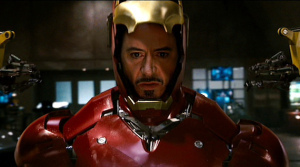 The first of the movies that would kickstart the mighty Marvel superhero movie franchise, this Jon Favreau movie presents us with an ordinary man in an extraordinary situation, who uses his genius to create a modern suit of high-tech armor and save himself from terrorist captives; only to discover those terrorists possess weapons his own company manufactured, sending him on a quest to protect people from his errant weapons (and the corporate partner who put them in the terrorists’ hands).�� Though the character is a comic-book superhero, the hero doesn’t have exotic, magic or alien powers, he only has science and technology on his side… making this clearly a sci-fi story.�� Director Favreau and actor Robert Downey, Jr. give us a perfectly-executed thrill ride that sets us up for further Marvel movies, some perhaps more fantasy than sci-fi, but all entertaining.
The first of the movies that would kickstart the mighty Marvel superhero movie franchise, this Jon Favreau movie presents us with an ordinary man in an extraordinary situation, who uses his genius to create a modern suit of high-tech armor and save himself from terrorist captives; only to discover those terrorists possess weapons his own company manufactured, sending him on a quest to protect people from his errant weapons (and the corporate partner who put them in the terrorists’ hands).�� Though the character is a comic-book superhero, the hero doesn’t have exotic, magic or alien powers, he only has science and technology on his side… making this clearly a sci-fi story.�� Director Favreau and actor Robert Downey, Jr. give us a perfectly-executed thrill ride that sets us up for further Marvel movies, some perhaps more fantasy than sci-fi, but all entertaining.
The rest of the Rolling Stone list:
Sunshine
Donnie Darko
Attack the Block
Primer
Minority Report
Moon
The World’s End
Her
Looper
Serenity
District 9
Gravity
Wall-E
Under The Skin
Inception
Children of Men
Bonus: Here are some more movies, which I think are better than Donnie Darko, Looper, Primer, District 9, Attack the Block, Gravity and, yes, even the fun-as-hell The World’s End, to create my own top-20 list:
The Adjustment Bureau (2011) This George Nolfi movie stars Matt Damon as a politician who stumbles onto a strange organization of people who seem to have knowledge of everyone’s intended fate, and the actions people must take���or be pushed into by agents of the Adjustment Bureau���to make that fate happen.�� When the hero initially resists the bureau’s efforts to keep him away from a woman who will derail his career if he falls in love with her, he is assisted by one of the men of the bureau, and the race to get to safety with the girl he loves is on.�� It’s not clear who the ultimate head of this bureau is (God himself?), but the bureaucrats are human enough, and the desire to fight to determine their own future makes this a powerful story, with love as the goal.�� And the agents’ hi-tech fate-mapping tools and secret network of doors to who-knows-where make this a fun sci-fi adventure.
This George Nolfi movie stars Matt Damon as a politician who stumbles onto a strange organization of people who seem to have knowledge of everyone’s intended fate, and the actions people must take���or be pushed into by agents of the Adjustment Bureau���to make that fate happen.�� When the hero initially resists the bureau’s efforts to keep him away from a woman who will derail his career if he falls in love with her, he is assisted by one of the men of the bureau, and the race to get to safety with the girl he loves is on.�� It’s not clear who the ultimate head of this bureau is (God himself?), but the bureaucrats are human enough, and the desire to fight to determine their own future makes this a powerful story, with love as the goal.�� And the agents’ hi-tech fate-mapping tools and secret network of doors to who-knows-where make this a fun sci-fi adventure.
Vanilla Sky (2001)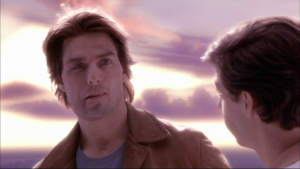 And again, Tom Cruise in a Cameron Crowe sci-fi movie that everyone dismissed because… Tom Cruise.�� But what at first appears to be a strange murder mystery surrounding a man who may be crazy, turns out to be a story about a man who realizes he is having nightmares about the women he loves, and the other woman who tried to kill him in the car crash.�� Though the movie was unfavorably compared to the Spanish film, Abra Los Ojos, from which it was remade, it received a number of award nominations, and was a box office success.�� Cruise, again, gets to really act in this film, and a very solid cast backs him up.�� But it is the subtle dropping of clues that his world isn’t what it seems, building to the big reveal at the end, that makes this movie so engaging.
And again, Tom Cruise in a Cameron Crowe sci-fi movie that everyone dismissed because… Tom Cruise.�� But what at first appears to be a strange murder mystery surrounding a man who may be crazy, turns out to be a story about a man who realizes he is having nightmares about the women he loves, and the other woman who tried to kill him in the car crash.�� Though the movie was unfavorably compared to the Spanish film, Abra Los Ojos, from which it was remade, it received a number of award nominations, and was a box office success.�� Cruise, again, gets to really act in this film, and a very solid cast backs him up.�� But it is the subtle dropping of clues that his world isn’t what it seems, building to the big reveal at the end, that makes this movie so engaging.
Cowboy Bebop: The Movie (2002)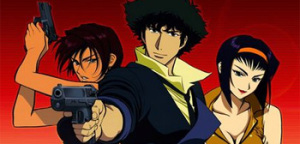 If this list can include Wall-E, why not an anime feature?�� Writer/director Shinichiro Watanabe took his incredibly rich Cowboy Bebop anime TV series, about a mildly-dysfunctional group of bounty hunters, and gave us a beautiful story about the team chasing down a psychopathic ex-soldier-turned-terrorist on the streets of Mars.�� Bebop depicts an incredibly believable future of human civilization spread among the solar system, and the crew of the Bebop are more fleshed-out than many live-action movie characters.�� Great action, beautiful city scenes, haunting music and the antics of the lovable crew make this a must-see for anyone’s anime catalog.
If this list can include Wall-E, why not an anime feature?�� Writer/director Shinichiro Watanabe took his incredibly rich Cowboy Bebop anime TV series, about a mildly-dysfunctional group of bounty hunters, and gave us a beautiful story about the team chasing down a psychopathic ex-soldier-turned-terrorist on the streets of Mars.�� Bebop depicts an incredibly believable future of human civilization spread among the solar system, and the crew of the Bebop are more fleshed-out than many live-action movie characters.�� Great action, beautiful city scenes, haunting music and the antics of the lovable crew make this a must-see for anyone’s anime catalog.
Paprika (2006)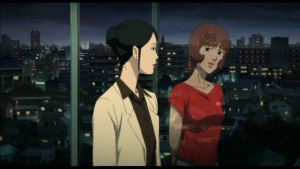 But wait!�� Cowboy Bebop wasn’t the only fantastic anime feature out there!�� Satoshi Kon’s movie is about a psychologist working with experimental technology allowing her to share a patient’s dreams, and uses her dream avatar, Paprika, to try to help them from within dreamland.�� But someone has figured out how to hack into the software, and as they get better at using the interface, the very fabric of reality is threatened.�� The psychologist and her colleagues work in the real world, as Paprika works in the dream world, to find and stop the hackers.�� Mind-bending imagery and psychological drama make this a great film.
But wait!�� Cowboy Bebop wasn’t the only fantastic anime feature out there!�� Satoshi Kon’s movie is about a psychologist working with experimental technology allowing her to share a patient’s dreams, and uses her dream avatar, Paprika, to try to help them from within dreamland.�� But someone has figured out how to hack into the software, and as they get better at using the interface, the very fabric of reality is threatened.�� The psychologist and her colleagues work in the real world, as Paprika works in the dream world, to find and stop the hackers.�� Mind-bending imagery and psychological drama make this a great film.
Cloud Atlas (2012)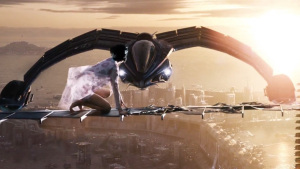 This series of interconnected stories, brought to the screen by Tom Tykwer and the Wachowskis, require the audience to pay some attention as they try to draw the connections between various characters in different stories.�� The official synopsis describes it as “an exploration of how the actions of individual lives impact one another in the past, present and future, as one soul is shaped from a killer into a hero, and an act of kindness ripples across centuries to inspire a revolution.”�� Incredible multiple-performances by Tom Hanks, Halle Berry, Hugh Grant, Susan Sarandon, Hugo Weaving and others, are used to visually suggest the souls that connect the characters and their evolution over time.
This series of interconnected stories, brought to the screen by Tom Tykwer and the Wachowskis, require the audience to pay some attention as they try to draw the connections between various characters in different stories.�� The official synopsis describes it as “an exploration of how the actions of individual lives impact one another in the past, present and future, as one soul is shaped from a killer into a hero, and an act of kindness ripples across centuries to inspire a revolution.”�� Incredible multiple-performances by Tom Hanks, Halle Berry, Hugh Grant, Susan Sarandon, Hugo Weaving and others, are used to visually suggest the souls that connect the characters and their evolution over time.
Snowpiercer (2014)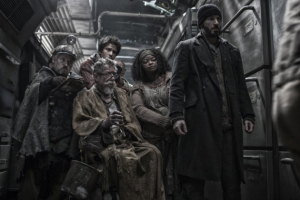 Normally post-apocalyptic sci-fi is a major yawnfest for me; but in this case, I’ll make a big exception.�� That’s because Joon-ho Bong‘s class-struggle story, set among the last human survivors of Earth riding aboard a non-stopping train on a globe-spanning line, is so full of symbolism, allegory and just plain ballsy visual style that it becomes an experience in itself to watch.�� Chris Evans leads the poor, desperate denizens of the back of the train along a linear mutiny to take over the controlling, luxurious front, giving the viewers a taste of the stratified cultures of life along the way, and the constant feeling of forced choice���go back, or go forward, but you can’t stay where you are.�� Like the train, the action never stops… until the inevitable end of the line.
Normally post-apocalyptic sci-fi is a major yawnfest for me; but in this case, I’ll make a big exception.�� That’s because Joon-ho Bong‘s class-struggle story, set among the last human survivors of Earth riding aboard a non-stopping train on a globe-spanning line, is so full of symbolism, allegory and just plain ballsy visual style that it becomes an experience in itself to watch.�� Chris Evans leads the poor, desperate denizens of the back of the train along a linear mutiny to take over the controlling, luxurious front, giving the viewers a taste of the stratified cultures of life along the way, and the constant feeling of forced choice���go back, or go forward, but you can’t stay where you are.�� Like the train, the action never stops… until the inevitable end of the line.
Interstellar (2014)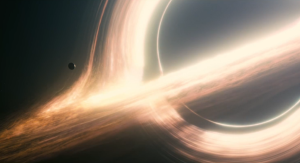 I honestly don’t know how Rolling Stone could justify leaving this off their list (but knowing them, they probably had issues with the sound balance)… nor how I, in my zeal to top them, actually missed it.�� Christopher Nolan’s epic, about a team of astronauts trying to find a future world for humanity, and dealing with the painful separation from their loved ones, is magnificent and beautiful.�� It also happens to be vetted by Kip Thorne, a Cal Tech physicist, to make it as scientifically accurate about wormholes and relativity as it can possibly be.�� Though the climax gets a lot of flack from audiences for being too dues ex machina, the final solution fully makes up for it in my opinion (and not insignificantly, because it matches my own theories on Mankind’s future habitats).
I honestly don’t know how Rolling Stone could justify leaving this off their list (but knowing them, they probably had issues with the sound balance)… nor how I, in my zeal to top them, actually missed it.�� Christopher Nolan’s epic, about a team of astronauts trying to find a future world for humanity, and dealing with the painful separation from their loved ones, is magnificent and beautiful.�� It also happens to be vetted by Kip Thorne, a Cal Tech physicist, to make it as scientifically accurate about wormholes and relativity as it can possibly be.�� Though the climax gets a lot of flack from audiences for being too dues ex machina, the final solution fully makes up for it in my opinion (and not insignificantly, because it matches my own theories on Mankind’s future habitats).
So, my top-20 list (as of 2014, of course):
A.I. Artificial Intelligence
Wall-E
Sunshine
The Adjustment Bureau
Inception
Minority Report
Iron Man
Moon
Her
Children of Men
War of the Worlds
Serenity
Cowboy Bebop: The Movie
Paprika
Under The Skin
Vanilla Sky
Snowpiercer
Solaris
Cloud Atlas
Interstellar
Actually, not a bad list.�� Good thing the 21st century pretty much just got started…


